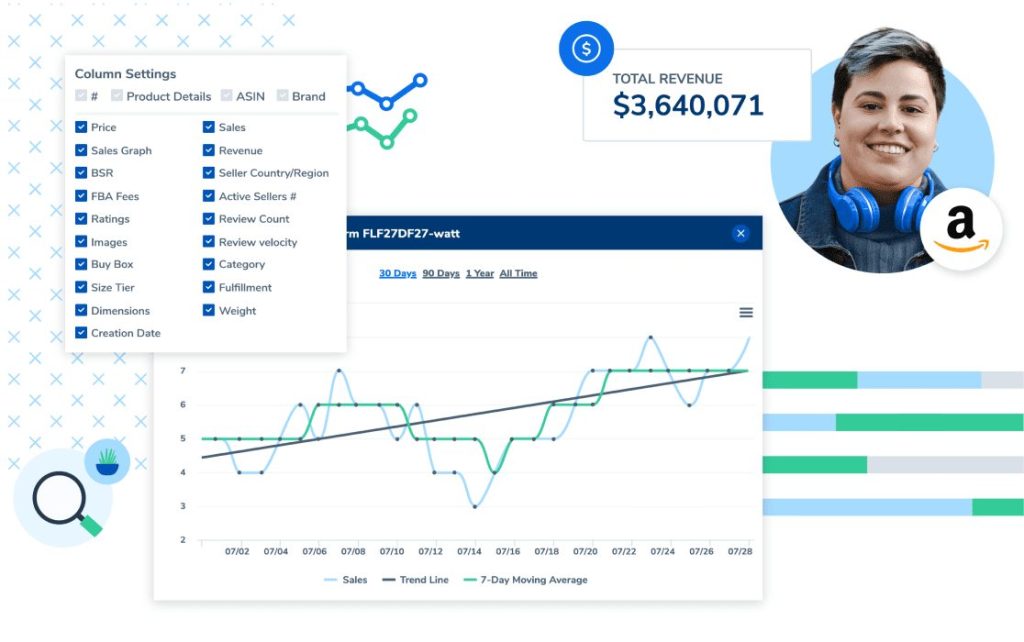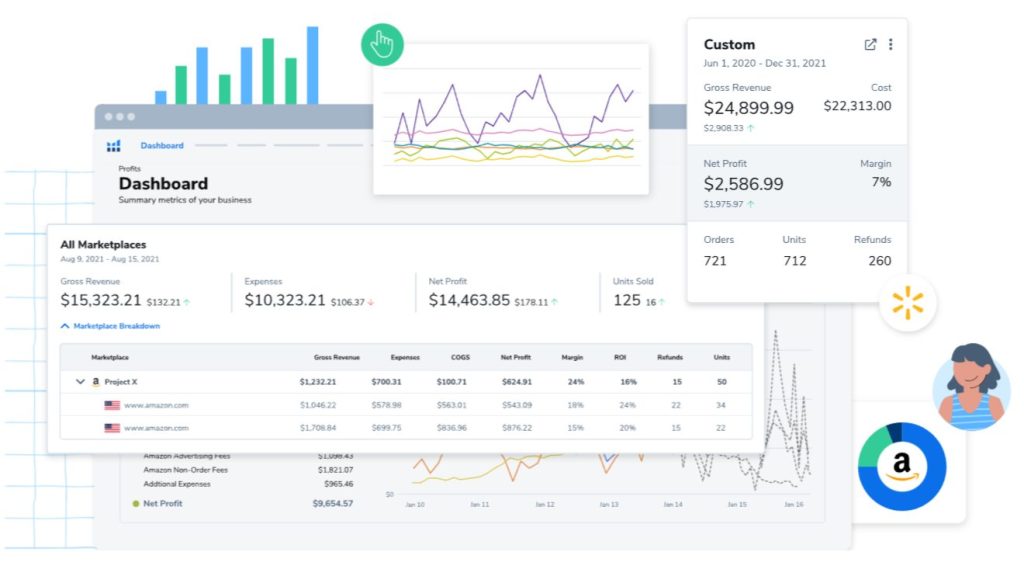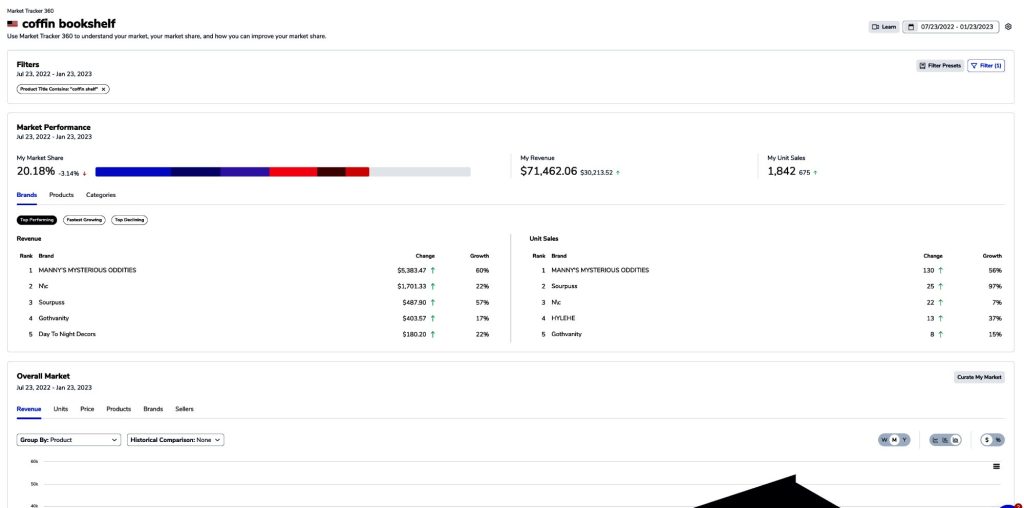Hey there! If you’re an Amazon seller looking to gain a competitive edge, then you’re in for a treat. In this article, I’ll be diving into the fascinating world of Helium 10 statistics. Now, you may be wondering what exactly Helium 10 is and how it can benefit your business. Well, let me tell you, it’s a game-changer.
Helium 10 is a powerful suite of tools designed specifically for Amazon sellers. It provides a wealth of data and insights that can help you make informed decisions and optimize your product listings.
But what sets it apart is its robust statistics feature. With Helium 10 statistics, you can uncover valuable information about your competitors, track keyword rankings, and even analyze historical trends. It’s like having a crystal ball for your Amazon business!
The Importance of Helium 10 Statistics:
When it comes to selling on Amazon, one thing is clear: data is power. As an experienced Amazon seller, I understand the need to gather and analyze accurate information to make informed business decisions.

This is where statistics come into play. With its robust suite of tools, Helium 10 provides sellers like me with the data and insights necessary to stay ahead of the competition and optimize our product listings.
The statistics feature of Helium 10 offers a wealth of valuable information that can make a real difference in the success of an Amazon business. Here are a few reasons why Helium 10 statistics are so important:
1. Uncover Key Competitor Insights:
With Helium 10 statistics, I can gain a deeper understanding of my competitors’ strategies and performance. By analyzing competitors’ sales data, product rankings, and customer reviews, I can identify areas where they excel and find opportunities to position my products more effectively.
2. Track Keyword Rankings:
In the highly competitive world of Amazon, keyword optimization is crucial. Helium 10 statistics allow me to track the rankings of the keywords associated with my products. This enables me to monitor the impact of my keyword strategies and make adjustments as needed to improve visibility and drive more organic traffic to my listings.
3. Analyze Historical Trends:
Past performance can often be a good indicator of future success. With statistics, I can analyze historical trends to identify patterns and understand how market conditions have changed over time.
This helps me make smart decisions about product selection, pricing, and inventory management, ensuring that I’m always adapting to the evolving Amazon marketplace.
The importance of Helium 10 statistics cannot be overstated. By providing sellers with valuable data and insights, Helium 10 empowers us to make data-driven decisions that can drive success on Amazon.
Whether it’s uncovering competitor strategies, tracking keyword rankings, or analyzing historical trends, statistics give me the competitive edge I need to thrive in the fast-paced world of e-commerce.
Understanding Helium 10 Metrics:
Helium 10 Metrics provide Amazon sellers with essential data insights into market trends, product performance, and consumer preferences, essential for strategic decision-making and optimizing online sales. This analytical toolset helps in identifying opportunities, enhancing listings, and boosting competitiveness in the vast Amazon marketplace.
Why are Helium 10 Statistics Important?
As an Amazon seller, staying on top of key metrics and statistics is essential for success. With the ever-growing competition on Amazon, it’s crucial to have access to real-time data and insights.
Helium 10 statistics provide sellers with a deep understanding of their business performance, allowing them to identify strengths, weaknesses, and areas for improvement.

By analyzing the statistics provided by Helium 10, sellers can gain valuable insights into their products, competitors, and market trends. This information can help them make data-driven decisions, optimize their product listings, and stay ahead of the competition.
Keyword Ranking Tracking:
Monitoring keyword rankings is crucial for Amazon sellers. Helium 10 provides detailed insights into the performance of keywords associated with your products. By tracking keyword rankings, sellers can identify which keywords are driving traffic and sales, and make the necessary optimizations to boost their visibility on Amazon.
Competitor Insights:
Understanding your competitors’ strategies and performance is vital. Helium 10’s statistics feature provides valuable information on competitor sales, market share, and keyword rankings. By monitoring these metrics, sellers can gain a competitive edge and stay ahead in the Amazon marketplace.
Historical Trends Analysis:
Helium 10 allows sellers to analyze the historical trends of their products. By studying sales data over time, sellers can identify seasonal patterns, spot potential opportunities, and make informed decisions about inventory management and marketing strategies.
Product Listing Optimization:
Helium 10 statistics offer insights into the performance of product listings. By analyzing metrics such as conversion rates and click-through rates, sellers can identify areas for improvement and optimize their listings to maximize sales and conversions.
Monitoring these key metrics provided by Helium 10 statistics is crucial for Amazon sellers looking to optimize their business and drive success on the platform. By leveraging these insights, sellers can make data-driven decisions, stay ahead of the competition, and achieve their business goals on Amazon.
How to Analyze and Interpret Helium 10 Statistics?
Analyzing and interpreting Helium 10 statistics is key to unlocking the full potential of your Amazon business by leveraging data-driven insights for strategic decision-making and operational optimization.
Analyzing Product Research Data:
When it comes to analyzing product research data with Helium 10 statistics, I find it incredibly valuable to identify trends and patterns. By examining metrics such as monthly sales, estimated revenue, and review ratings, I gain insights into the performance and viability of different products.
Here are a few key steps I take when analyzing product research data:
- Identify High-Demand Products: I look for products with a high sales volume and revenue potential, as these can indicate a strong market demand.
- Analyze Competition: I examine the number of sellers and the level of competition for a particular product niche. This helps me gauge the level of difficulty I may face when entering the market.
- Evaluate Review Ratings: I pay close attention to review ratings as they give insight into customer satisfaction and product quality. A high number of positive reviews can indicate a popular and well-received product.
- Consider Market Saturation: I assess the number of sellers actively selling a particular product and the level of saturation in the market. This helps me gauge the potential for growth and profitability.
Interpreting Sales and Revenue Metrics:
Understanding sales and revenue metrics is crucial for making data-driven decisions. With Helium 10 statistics, I can track sales performance and revenue generation over time to spot changes and opportunities for improvement.
Here are some important metrics I focus on when interpreting sales and revenue data:
- Monthly Sales: Tracking monthly sales helps me identify seasonal trends, fluctuations, and growth patterns. It allows me to adjust my inventory levels and marketing strategies accordingly.
- Estimated Revenue: By analyzing estimated revenue, I can calculate my profit margin and assess the financial viability of a product. It helps me determine whether investing in a particular product is worth it.
- Conversion Rate: The conversion rate measures the percentage of customers who purchase after visiting a product listing. Monitoring this metric helps me understand the effectiveness of my product listing and optimize it if needed.
Evaluating Keyword Performance:
Effectively optimizing product listings involves evaluating keyword performance. With Helium 10 statistics, I can monitor keyword rankings and identify opportunities to improve visibility and organic traffic.
Here’s how I evaluate keyword performance using Helium 10 statistics:
- Track Keyword Rankings: By monitoring keyword rankings, I can determine which keywords are driving traffic and conversions. If certain keywords are performing well, I prioritize them in my listing optimization efforts.
- Identify High-Volume Keywords: Helium 10 statistics provide insights into the search volume of keywords. I focus on identifying high-volume keywords with low competition to increase my chances of ranking higher in search results.
- Optimize Keyword Placement: Using statistics, I analyze which keywords are indexed in my product listing and adjust their placement accordingly. This helps improve visibility and relevancy.
Tracking Competitor Analysis:
Keeping an eye on competitors is crucial for staying ahead in the Amazon marketplace. Helium 10 statistics offer valuable insights into competitor data, helping me understand their strategies and identify areas for improvement.

Here’s how I track competitor analysis with Helium 10 statistics:
- Analyze Listing Metrics: I compare my product listing metrics with those of my competitors, such as review ratings, sales performance, and pricing. This helps me identify strengths and weaknesses and adjust my tactics accordingly.
- Identify Competitor Keywords: Helium 10 statistics allow me to analyze the keywords my competitors are ranking for. This information helps me identify potential keywords to target in my listing optimization efforts.
- Monitor Pricing Strategies: I track competitor pricing trends using statistics to ensure that my pricing remains competitive. This helps me adjust my pricing strategy and attract more customers.
By effectively analyzing and interpreting Helium 10 statistics, I can make informed decisions, optimize my products and listings, and ultimately drive success on Amazon.
Tips for Optimizing Helium 10 Statistics:
By leveraging the power of statistics, Amazon sellers can gain a competitive edge in the marketplace. Analyzing and interpreting these statistics is crucial for making data-driven decisions that can drive success.
Throughout this article, I have discussed the importance of understanding various metrics, such as monthly sales, estimated revenue, and review ratings, to gain insights into product performance and viability.
To optimize statistics, it is essential to identify trends and patterns in product research data. By tracking keyword performance and conducting competitor analysis, sellers can stay ahead of the game and make informed decisions to improve their products and listings.
By utilizing statistics effectively, sellers can optimize their listings, increase conversions, and ultimately drive more sales on Amazon. Remember, success on Amazon is all about staying informed, understanding the data, and making strategic decisions based on the insights gained from these statistics.
So, start leveraging statistics today and take your Amazon business to new heights. With the right tools and knowledge, you can achieve your goals and thrive in the competitive world of e-commerce.
Frequently Asked Questions:
Helium 10 statistics provide valuable insights into product performance and viability. By analyzing data such as monthly sales, estimated revenue, and review ratings, sellers can identify trends and patterns, make data-driven decisions, and optimize their products and listings for success on Amazon.
Sellers can analyze and interpret Helium 10 statistics by understanding sales and revenue metrics, evaluating keyword performance, and tracking competitor analysis. This involves studying monthly sales, estimated revenue, and conversion rate, as well as identifying high-performing keywords and studying competitor strategies to gain a competitive advantage.
Identifying trends and patterns in product research data allows sellers to understand market demand, spot opportunities, and make strategic decisions. By analyzing factors like monthly sales, estimated revenue, and review ratings, sellers can uncover valuable insights that inform product selection, optimization, and marketing strategies.
Helium 10 provides tools for tracking competitor analysis. Sellers can monitor competitor’s product listings, sales volume, and keyword rankings. By tracking these metrics, sellers can gather insights into competitor strategies, identify gaps in the market, and adjust their strategies to gain a competitive edge.
